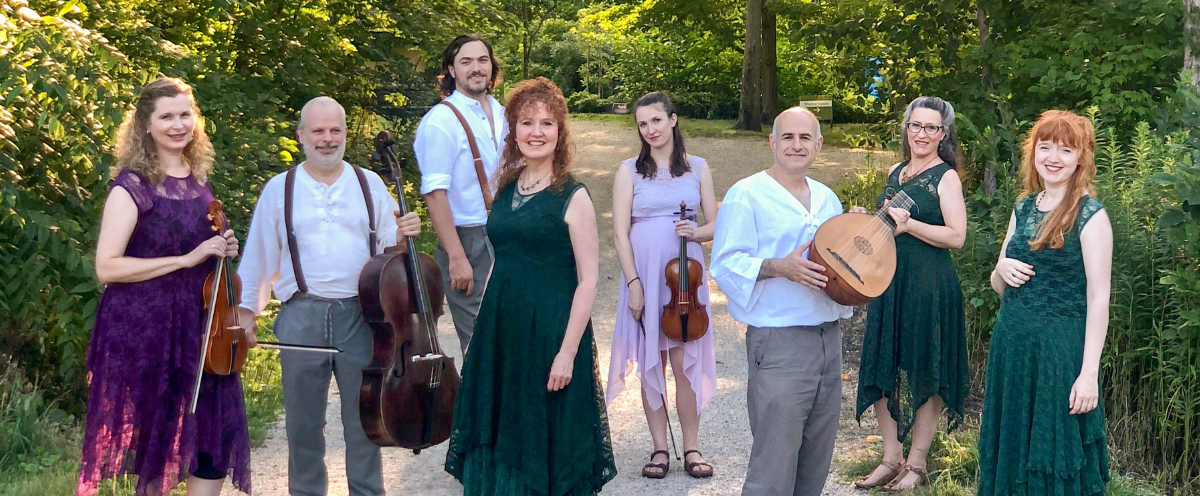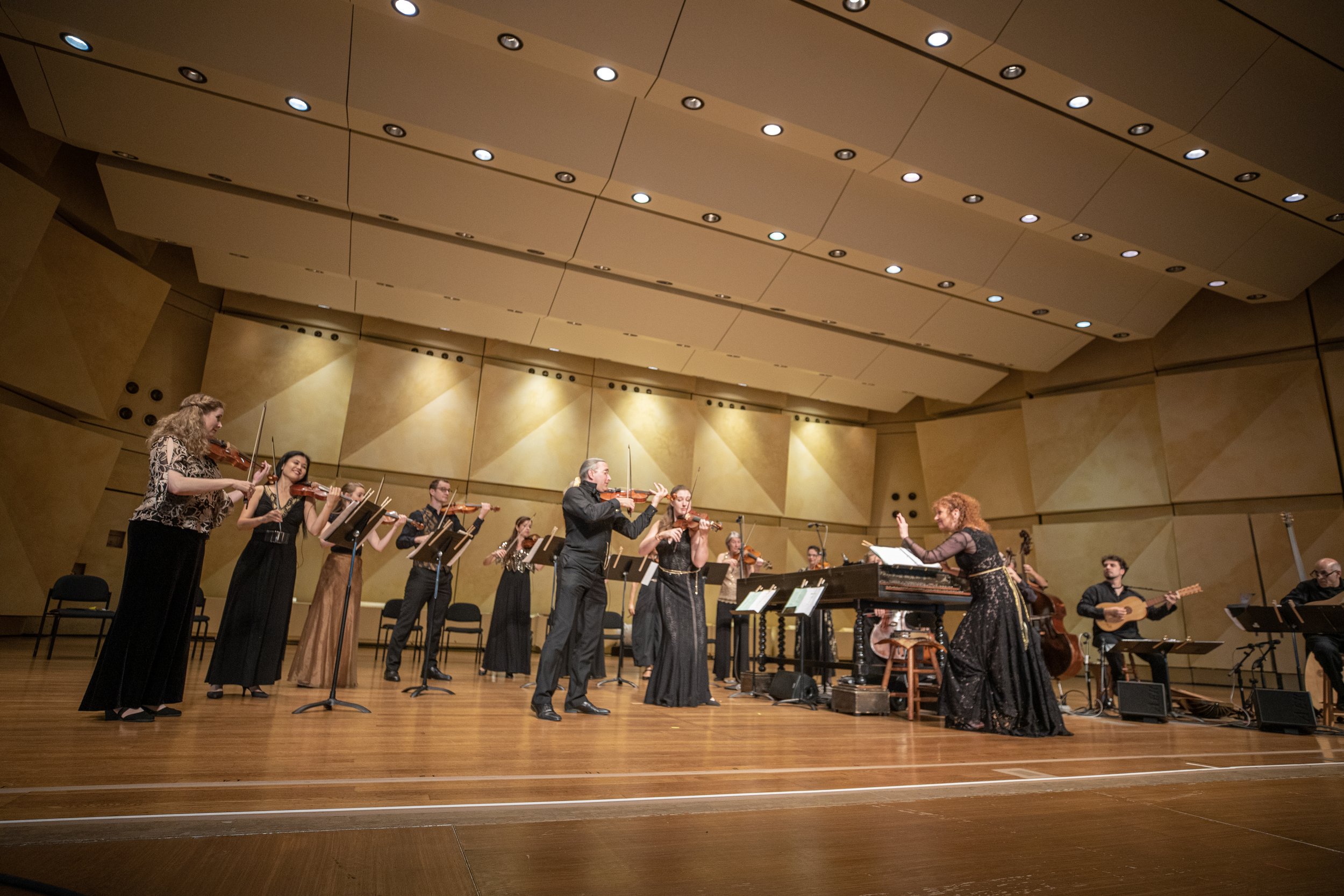Aural Tradition
By Mark Thomas Ketterson
When internationally celebrated conductor and harpsichordist Jeannette Sorrell was a child in San Francisco, she practiced piano at home on a paper keyboard. The idea that Sorrell would someday become the mastermind behind Apollo’s Fire, Cleveland’s award-winning Baroque orchestra, wasn’t on anyone’s mind then; but her passion and ingenuity were already evident. A serious student of violin and ballet, Sorrell had long wanted piano lessons, but her family did not have an instrument. Finally, when lessons became possible through her grammar school, the then-9-year-old Sorrell admits that “I lied, and said we had one. Then I made myself a paper keyboard and practiced on that. And I did that for a year”.
Fast forward to adolescence, which found Sorrell living in the Shenandoah Valley, where she was first introduced to Southern shape-note harmonies and Shaker hymns that “are built on open fourths and fifths that almost sound medieval. I didn’t know much about early music at that point, but I was drawn to those harmonies and colors.”
Fast forward a bit more to Aspen Music Festival, where the 18-year-old musician studied with the focused goal of determining if she wanted to continue with piano or become a conductor. Conducting won and became her major. She was required to have a second instrument and chose the harpsichord—initially because she thought it would be easier, given her keyboard experience. She soon realized that “this was my instrument.”
Sorrell continued her studies at Oberlin and in the conducting program at Tanglewood, where she studied with Leonard Bernstein and Roger Norrington. She was soon on faculty at Oberlin’s summer Baroque institute and conducting at Aspen. Apollo’s Fire was still in the future, but it was clear that Sorrell was destined for greatness.
Jeannette Sorrell conducts Apollo’s Fire from her harpsichord, providing the musical “grounding” in every sense.
Her opportunity came in an oddly unorthodox manner. Sorrell was asked to interview for a position as assistant conductor with the Cleveland Orchestra. She hadn’t sought it out. “I didn’t even know I was on their list,” she clarifies. Upon attending the interview, Cleveland’s music director, Christoph von Dohnányi, told her point–blank that he would not offer her an audition because she was a woman. Sorrell was stunned. “This was 1992, not the dark ages.” She countered Dohnányi with some blunt force of her own, reminding him that she didn’t call them, they called her, and as an early-music specialist she wasn’t much interested anyway. “It was not a politic thing to say, but it was the truth. It’s deeply ironic, as I now look back on it as a lesson in the value of being true to yourself.”
Indeed, it was. Roger Wright, the orchestra’s artistic administrator, had long admired Sorrell’s music; now he was impressed with her extraordinary moxie. Wright drew her aside to share that he had long wanted to launch a period-instrument orchestra in Cleveland, and felt she was just the conductor to make it happen. Apollo’s Fire was born.
Sorrell and her Grammy Award–winning ensemble now have over 26 commercial recordings to their credit and have performed all over the world in a repertory ranging from the great works of Bach, Handel, and Vivaldi (Chicago audiences will particularly remember a glorious performance of the Monteverdi Vespers last season) to the folk music traditions of America, Britain, and the Middle East, all presented with 17th-century flair. The orchestra is guided by strict observance of the foundational Baroque ideal of Affekt, or The Doctrine of Affections.
As the musicians access the emotions written into Baroque music to evoke the Affekt, unsurprisingly the moments of humor also play out in their stage presence.
Ravinia audiences, equally familiar with the Ohioans’ affective affinity for potpourris of the Baroque period, may experience one of Maestro Sorrell’s most intriguing conceptions to date on July 8 when Apollo’s Fire returns to the Martin Theatre with The Road to Dublin, Sorrell’s creative sequel to the much beloved Sugarloaf Mountain: An Appalachian Gathering. Ravinia sat down with Sorrell to discuss this delightful new program as well as to glean her thoughts on period performance practice and its relationship to the more rustic world of traditional folk music.
Explain the Baroque ideal of Affekt.
This is the concept that music writers of the 17th and 18th centuries talked about, the idea that music has the power to move emotions. The role of the performer was to consciously manipulate the emotions of the listeners. Early Baroque composers, especially in Italy, were trying to re-create the emotional power of ancient Greek music, which was said to be able to cause a crowd to go into a riot or be peaceful. The main tool for this is what they called “rhetoric.” Think about ancient orators; they could manipulate a crowd through the pacing of their speech and the rising power of their voices. They could build up excitement, and suspense—then gently bring it down to quiet contemplation. When I started Apollo’s Fire, I knew this is what Baroque music was supposed to be about, but many period groups at the time didn’t seem to be focused on this. I decided this was going to be our ‘thing.’ We focus on Affekt and rhetoric and moving the emotional needs of listeners. We’re conscious of that with every phrase we play.
Apollo’s Fire has enjoyed tremendous success in ‘classical’ Baroque rep—but then we hear your wonderful collections of Appalachian music like Come to the River and Sugarloaf Mountain, as well as explorations of Jewish Sephardic music. What does Baroque music have in common with ancient folk tradition?
In the 17th century there wasn’t a high wall between art music and popular music. The great composers like William Byrd and his colleagues, who wrote elaborate masses, were also writing variations on popular tavern songs. In Italy, the early Baroque composers provided virtuoso variations for voice and violin over ground bass patterns that were the go-to dance tunes that everybody knew, the chaconne, the passacaglia, the gigue. To me, it’s not a big leap. We wanted to explore where that folk music came from. We were playing summer concerts in a rustic barn outside of Cleveland, and I felt this rustic venue needed rustic repertoire. I worked with a wonderful Baroque violinist that I knew who also specialized in Scottish music from Cape Breton. Then we moved to Irish, then to Appalachian, and eventually into Sephardic, which was a bigger jump.
It’s like learning a foreign language: once you’ve learned one or two it becomes very easy to learn the third and the fourth. After we had learned Scottish and Irish, it became easier to learn other styles, but always through working with folk musicians who are steeped in those traditions. That’s important, because it’s an oral tradition, it’s not written down. What Appalachian music really is, is British Isles music that came across with the immigrants, then got mixed up a little bit with influences of gospel and things and took on what we think of as an American accent. But it was rooted in Irish and Scottish music.
Your programs have a distinct thread of storytelling. We tend to think of ‘program music’ as a Romantic invention; do you feel the Baroque has a closer connection to narrative music than is generally thought?
I would have to say yes. We just played The Four Seasons in London [and that was our first program at Ravinia]. Vivaldi was a master of storytelling. We love playing it. But I also do a number of Baroque programs that feature, let’s say, storm and tempest music, which is essentially program music. Or Baroque music that evokes colorful folk dances like you get in the French Baroque; often they’re imitating Arabic, or Egyptian, or Native American music, always with a high degree of naïveté. But I feel like there are quite a lot of ‘programs’ that can brew in the Baroque repertoire.
So, tell us about The Road to Dublin.
Folk singer/instrumentalist Fiona Gillespie and fiddlers Susanna Perry Gilmore and Caitlin Hedge help authentically share the “language” of early and traditional music using instruments from that time period.
I structured this program in a different way than any other. There’s a famous ballad called ‘The Rocky Road to Dublin,’ which Irish fans will know. It has several verses, and the person who is telling the story goes through various misadventures on his way to Dublin along the rocky road. I thought it would be fun to take each stanza of that ballad and create a set out of it, using pieces by other composers from the time that reflect on the theme of that stanza. So, the various adventures of this unfortunate man on his way to Dublin are each amplified as a whole set. He encounters fair lasses, a robber, loses his bundle, gets beaten up by some Liverpool boys because of his Irish accent. Each of those stanzas becomes a set, so we are following his story throughout the entire concert.
Speaking of program music …
Exactly. Then at the end, we hear the whole ballad. We premiered it in Cleveland last summer, and people seemed to really love it. It’s mostly lighthearted, but there is a section where we look at the Irish immigrants who left their homes for America due to starvation and poverty. That I think is very poignant.
Stories of The Road to Dublin are told with a few props as well as song.
How do you feel about returning to Chicago and Ravinia?
We have now finished two years of what we call our Windy City miniseries. We are playing in Chicago about three times a year, so we will be back in the fall and the winter. But we are so excited to return to Ravinia! This will be our fourth visit, and we’ve just always had such a great time there. We’ve been twice in the Martin Theatre; last time we were in the Pavilion. Ravinia is such a beautiful park—and I think it’s amazing that so many people sit out there on the Lawn to listen. The audiences at Ravinia are really very special! ■
Mark Thomas Ketterson is the Chicago correspondent for Opera News and program annotator for Atlanta Opera. He has also written for Playbill, the Chicago Tribune, Atlanta Journal Constitution, ArtsATL, Lyric Opera of Chicago, Washington National Opera, the Edinburgh Festival, and Wolf Trap.






